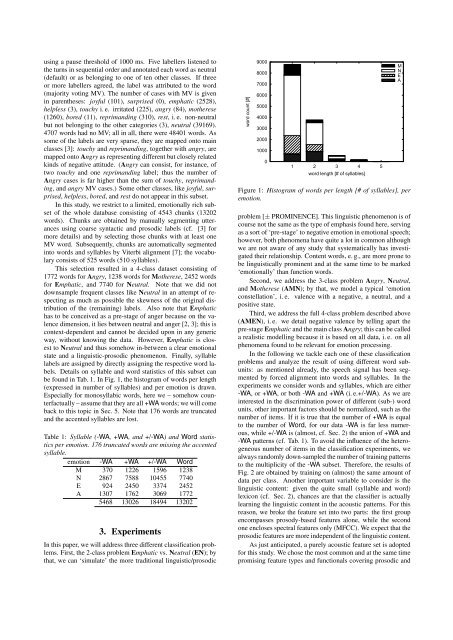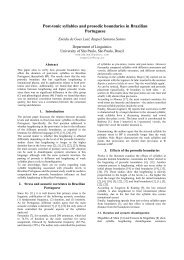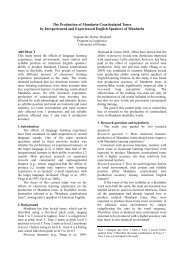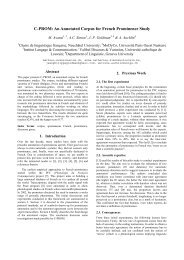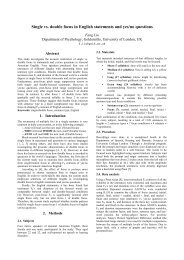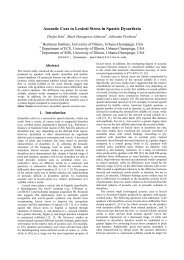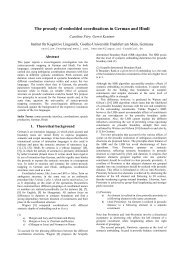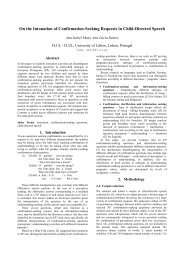Word Accent and Emotion - Speech Prosody 2010
Word Accent and Emotion - Speech Prosody 2010
Word Accent and Emotion - Speech Prosody 2010
You also want an ePaper? Increase the reach of your titles
YUMPU automatically turns print PDFs into web optimized ePapers that Google loves.
using a pause threshold of 1000 ms. Five labellers listened to<br />
the turns in sequential order <strong>and</strong> annotated each word as neutral<br />
(default) or as belonging to one of ten other classes. If three<br />
or more labellers agreed, the label was attributed to the word<br />
(majority voting MV). The number of cases with MV is given<br />
in parentheses: joyful (101), surprised (0), emphatic (2528),<br />
helpless (3), touchy i. e. irritated (225), angry (84), motherese<br />
(1260), bored (11), reprim<strong>and</strong>ing (310), rest, i. e. non-neutral<br />
but not belonging to the other categories (3), neutral (39169).<br />
4707 words had no MV; all in all, there were 48401 words. As<br />
some of the labels are very sparse, they are mapped onto main<br />
classes [3]: touchy <strong>and</strong> reprim<strong>and</strong>ing, together with angry, are<br />
mapped onto Angry as representing different but closely related<br />
kinds of negative attitude. (Angry can consist, for instance, of<br />
two touchy <strong>and</strong> one reprim<strong>and</strong>ing label; thus the number of<br />
Angry cases is far higher than the sum of touchy, reprim<strong>and</strong>ing,<br />
<strong>and</strong> angry MV cases.) Some other classes, like joyful, surprised,<br />
helpless, bored, <strong>and</strong> rest do not appear in this subset.<br />
In this study, we restrict to a limited, emotionally rich subset<br />
of the whole database consisting of 4543 chunks (13202<br />
words). Chunks are obtained by manually segmenting utterances<br />
using coarse syntactic <strong>and</strong> prosodic labels (cf. [3] for<br />
more details) <strong>and</strong> by selecting those chunks with at least one<br />
MV word. Subsequently, chunks are automatically segmented<br />
into words <strong>and</strong> syllables by Viterbi alignment [7]; the vocabulary<br />
consists of 525 words (510 syllables).<br />
This selection resulted in a 4-class dataset consisting of<br />
1772 words for Angry, 1238 words for Motherese, 2452 words<br />
for Emphatic, <strong>and</strong> 7740 for Neutral. Note that we did not<br />
downsample frequent classes like Neutral in an attempt of respecting<br />
as much as possible the skewness of the original distribution<br />
of the (remaining) labels. Also note that Emphatic<br />
has to be conceived as a pre-stage of anger because on the valence<br />
dimension, it lies between neutral <strong>and</strong> anger [2, 3]; this is<br />
context-dependent <strong>and</strong> cannot be decided upon in any generic<br />
way, without knowing the data. However, Emphatic is closest<br />
to Neutral <strong>and</strong> thus somehow in-between a clear emotional<br />
state <strong>and</strong> a linguistic-prosodic phenomenon. Finally, syllable<br />
labels are assigned by directly assigning the respective word labels.<br />
Details on syllable <strong>and</strong> word statistics of this subset can<br />
be found in Tab. 1. In Fig. 1, the histogram of words per length<br />
(expressed in number of syllables) <strong>and</strong> per emotion is drawn.<br />
Especially for monosyllabic words, here we – somehow counterfactually<br />
– assume that they are all +WA words; we will come<br />
back to this topic in Sec. 5. Note that 176 words are truncated<br />
<strong>and</strong> the accented syllables are lost.<br />
Table 1: Syllable (-WA, +WA, <strong>and</strong> +/-WA) <strong>and</strong> <strong>Word</strong> statistics<br />
per emotion. 176 truncated words are missing the accented<br />
syllable.<br />
emotion -WA +WA +/-WA <strong>Word</strong><br />
M 370 1226 1596 1238<br />
N 2867 7588 10455 7740<br />
E 924 2450 3374 2452<br />
A 1307 1762 3069 1772<br />
5468 13026 18494 13202<br />
3. Experiments<br />
In this paper, we will address three different classification problems.<br />
First, the 2-class problem Emphatic vs. Neutral (EN); by<br />
that, we can ‘simulate’ the more traditional linguistic/prosodic<br />
word count [#]<br />
9000<br />
8000<br />
7000<br />
6000<br />
5000<br />
4000<br />
3000<br />
2000<br />
1000<br />
0<br />
1 2 3 4 5<br />
word length [# of syllables]<br />
Figure 1: Histogram of words per length [# of syllables], per<br />
emotion.<br />
problem [± PROMINENCE]. This linguistic phenomenon is of<br />
course not the same as the type of emphasis found here, serving<br />
as a sort of ‘pre-stage’ to negative emotion in emotional speech;<br />
however, both phenomena have quite a lot in common although<br />
we are not aware of any study that systematically has investigated<br />
their relationship. Content words, e. g., are more prone to<br />
be linguistically prominent <strong>and</strong> at the same time to be marked<br />
‘emotionally’ than function words.<br />
Second, we address the 3-class problem Angry, Neutral,<br />
<strong>and</strong> Motherese (AMN); by that, we model a typical ‘emotion<br />
constellation’, i. e. valence with a negative, a neutral, <strong>and</strong> a<br />
positive state.<br />
Third, we address the full 4-class problem described above<br />
(AMEN), i. e. we detail negative valence by telling apart the<br />
pre-stage Emphatic <strong>and</strong> the main class Angry; this can be called<br />
a realistic modelling because it is based on all data, i. e. on all<br />
phenomena found to be relevant for emotion processing.<br />
In the following we tackle each one of these classification<br />
problems <strong>and</strong> analyze the result of using different word subunits:<br />
as mentioned already, the speech signal has been segmented<br />
by forced alignment into words <strong>and</strong> syllables. In the<br />
experiments we consider words <strong>and</strong> syllables, which are either<br />
-WA, or +WA, or both -WA <strong>and</strong> +WA (i. e.+/-WA). As we are<br />
interested in the discrimination power of different (sub-) word<br />
units, other important factors should be normalized, such as the<br />
number of items. If it is true that the number of +WA is equal<br />
to the number of <strong>Word</strong>, for our data -WA is far less numerous,<br />
while +/-WA is (almost, cf. Sec. 2) the union of +WA <strong>and</strong><br />
-WA patterns (cf. Tab. 1). To avoid the influence of the heterogeneous<br />
number of items in the classification experiments, we<br />
always r<strong>and</strong>omly down-sampled the number of training patterns<br />
to the multiplicity of the -WA subset. Therefore, the results of<br />
Fig. 2 are obtained by training on (almost) the same amount of<br />
data per class. Another important variable to consider is the<br />
linguistic content: given the quite small (syllable <strong>and</strong> word)<br />
lexicon (cf. Sec. 2), chances are that the classifier is actually<br />
learning the linguistic content in the acoustic patterns. For this<br />
reason, we broke the feature set into two parts: the first group<br />
encompasses prosody-based features alone, while the second<br />
one encloses spectral features only (MFCC). We expect that the<br />
prosodic features are more independent of the linguistic content.<br />
As just anticipated, a purely acoustic feature set is adopted<br />
for this study. We chose the most common <strong>and</strong> at the same time<br />
promising feature types <strong>and</strong> functionals covering prosodic <strong>and</strong><br />
M<br />
N<br />
E<br />
A


